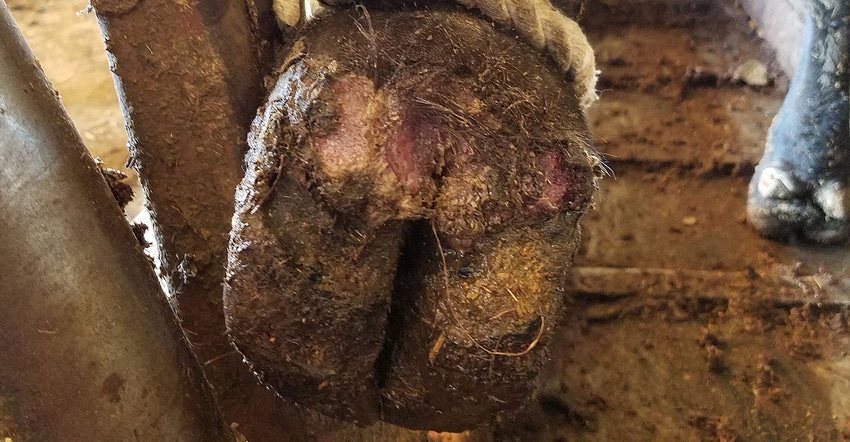July 7, 2022

Digital dermatitis, especially hairy heel wart, used to be only thought of as a problem in dairy cows, but it seems to be more of a problem with beef cattle. The problem can cause losses in performance and sometimes even death in feedlot cattle.
Terry Engelken, professor of veterinary diagnostic and production animal medicine at Iowa State University, says hairy heel warts are caused by one or more pathogens, which cause lesions on the skin of the back side of the foot, and nearly 90% of the time are present on the back feet. “The lesions are usually circular or oval, with clearly demarcated edges. Without treatment, it will cause major lameness issues,” he says.
Animals suffering from this condition will show a shift in weight from the front of the toe to keep lesions off of the floor. This leads to a decrease in walking activity and feed intake, and decreased feeding performance.
This type of digital dermatitis is found more in wet environments with mud and/or manure present, and it seems also to be more prevalent in groups that have come from different sources — as more bacteria is present.
“In feedlot cattle, we see more hairy heel warts in the cattle at reimplant time, or 90 to 100 days into the on-feed cycle,” Engelken says. “The lesions will go from acute to chronic over time if not treated.”
Shane Terrell, a Gothenburg, Neb. Veterinarian, says lameness has the biggest opportunity for improvement in the modern feedlot industry. Improvement can be made through cleanliness of pens and buildings, proper handling and good nutrition.
“We can measure the amount of lameness first by locomotion scoring, and when we see a failure of an animal to keep up with the cattle in the rest of the pen,” Terrell says. “It’s a 0 to 3 score, with 0 being a normal walking animal and 3 being an animal reluctant to even move.”
Treatment
Early detection and intervention are key to stopping a lameness problem. Terrell says there are many causes for lameness, including foot rot, a septic joint, laceration of the foot or hoof wall, laminitis, toe or sole ulcer, and hairy heel wart. Once the problem is identified, a treatment plan can be developed. “Prevention is the best way to deal with lameness causes; effectively killing the pathogens and proper hygiene in pens and around water tanks will help,” he says.
Engelken and Terrell agree a routine footbath will help with prevention. This should include copper sulfate or formaldehyde in the water. A footbath should be big enough for each foot to get two dunks in the treated water, and should be dewclaw-deep. Engelken says to use your best judgment for when the water needs to be changed — but it definitely should be changed after 250 head have used it.
“If 30% of the pen shows any sign of hairy heel wart, that pen should automatically be enrolled into a footbath program, repeating treatment every three to four weeks for maintenance until shipping,” Terrell says. “By understanding the value of proper treatment and prevention, including a tetracycline topical and wrapping the foot if needed, animals will perform so much more efficiently.”
Project looking for solutions
Engelken says a digital dermatitis project funded through the Iowa Beef Industry Council is helping with finding an easier way to prevent this problem. “We are collecting samples and preserving them in liquid nitrogen to be able to study the DNA, and see what they look like under a microscope and genetically. Pinpointing an exact source for hairy heel warts has been the biggest challenge.”
By better understanding how the organism survives in the environment, Engelken thinks the chances of developing a vaccine become more of a reality. Additional technology is being studied to treat bedding to fight the organisms present.
“We are seeing some bacterial resistance in digital dermatitis in certain cases, which is leading us to look for natural immunity. We need to be sure treatments are cost-effective to help improve the bottom line and prevent loss in days on feed,” Engelken concludes.
Locomotion scoring to determine level of lameness
Here is a description of what the scores from 0 to 3 mean:
0 = Animal walks normally, with no gait changes.
1 = Animal has a shortened stride length. Head may bob some, but it is hard to tell which foot is the problem.
2 = Animal has an obvious limp, but still bears weight on the foot. A head bob is present.
3 = Animal is reluctant to move and applies little or no weight to the affected foot.
About the Author(s)
You May Also Like






